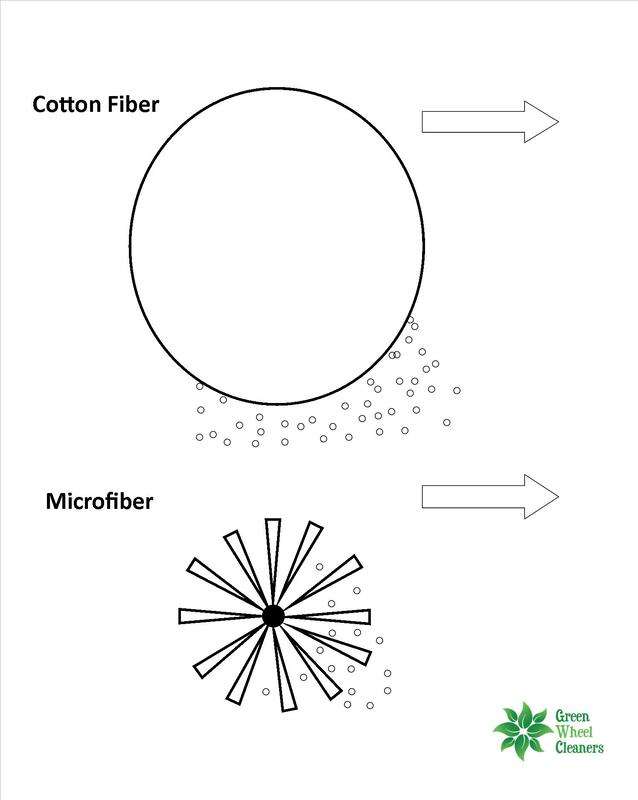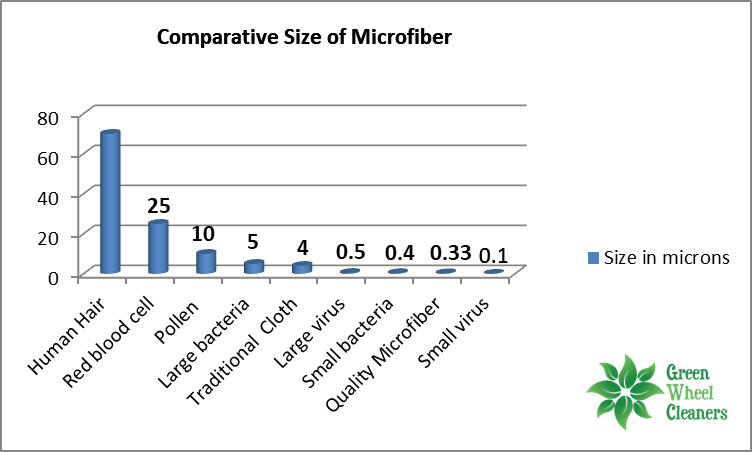The use of microfiber in the cleaning industry has been revolutionary. It has reduced the required cleaning time in buildings, and has been producing better overall cleanliness and disinfection. Even though microfiber technology has reduced the need for toxic cleaning chemicals, many cleaning companies still feel they need to rely heavily on these chemicals even though they can be damaging to the health of the buildings occupants. However, as more studies are carried out showing how microfiber can remove pathogens, the trend toward less toxic cleaning methods is thankfully increasing.
WHAT IS MICROFIBER?
Microfiber is a fiber or filament that is approximately between 0.3 dtex and 1 dtex in diameter. To put this into context this is roughly one hundred times finer than a human hair. These fibers are then woven together to produce a cloth. Although other materials can be used to make the fibers, for cleaning cloths they are usually produced from a combination of polyester and polyimides, with a much larger portion of that being polyester.
HOW MICROFIBER WORKS FOR CLEANING.
Because microfibers are so small, and there are so many of them in a microfiber cloth or mop head, they have a much larger cleaning surface then traditional cotton cloths. This means that they have more contact with the dirt and pathogens and are able to get into crevasses on surfaces that larger fibers cannot. Once the microfibers make contact with particles, they are also able to trap the particles much better than cotton fibers. To make the microfibers even thinner, the manufacturers split the microfiber further to produce asterisk-like fibers. Because of the split fibers, particles and pathogens are not just being moved around but are instead trapped inside the cloth. The microfiber cloths can then be washed to remove the particles.

MICROFIBER DOES NOT RELY ON CHEMICALS TO CLEAN AND DISINFECT.
Because there are so many micro polyester and polyimide fibers in a microfiber cloth, the fibers create static charges when they rub together. This static charge attracts the dust and dirt to the cloth like a magnet. This makes cleaning with microfiber cloths fast and efficient and reduces the need for chemicals to first emulsify the dirt.
Traditional cloths and mops are used to apply cleaning chemical solutions to surfaces to emulsify the dirt and kill pathogens before the solution is wiped away. There are a number of issues with this method. Firstly, for most disinfectants, the disinfectant needs to sit on the surface for a period of time for the chemicals to fully kill the pathogens. This sitting time however, often does not happen.
People very often spray the disinfectant, then wipe right away. This can lead to pathogens not being properly killed and can result in the production of resilient strains of the pathogens. The other problem is that the chemicals used, often leave a residue on the surfaces. So instead of a surface that is meant to be clean and disinfected, we are left, not only with bacteria that may not have been properly killed, but also a residue of toxic chemicals. Exposure to these chemicals have been shown be related to cancers, asthma, hormonal disruption, allergies and autoimmune diseases.1-16
Rather than using toxic chemical cleaners to emulsify dirt and kill pathogens, microfiber cloths remove the dirt and pathogen through the mechanical properties of the fibers themselves. The microfiber cloths use static charges and capillary action to attract and trap particles. Quality microfibers are smaller than most bacteria and even some viruses, so they are able to trap and remove these pathogens from most surfaces.

Cleaning products may be required if the particles are bonded to a surface, but the products used to break these bonds do not have to be toxic. Orange oil for example will remove heavy grease, glue, and even permanent marker from surfaces. For less heavy grease removal however, the microfiber does not need any other products. Polyesters like to bind to fat. This is why microfiber cloths can be used to wipe away fingerprints from glass without adding detergents.
There have been an increasing number of scientific studies that have shown the effectiveness of using non-toxic cleaning. Some of these studies were carried out in hospitals and found that microfiber along with steam and water, were extremely effective in minimizing the spread of infections in clinical environments 17,18,19
Professional janitorial companies help the owners of business project the professional image they are looking for, but they also should help protect the health of the occupants of building. If the purpose is to protect the health of building occupants, then we should be looking at ways to reduce the amount of toxic chemicals we bring into buildings. The increased use of microfiber and the reduction in the use of harmful chemicals will go a long way to protecting employee health.
If you would like any more information or would like to book a time to get a free quote for non-toxic office cleaning in Victoria BC. Contact us today
